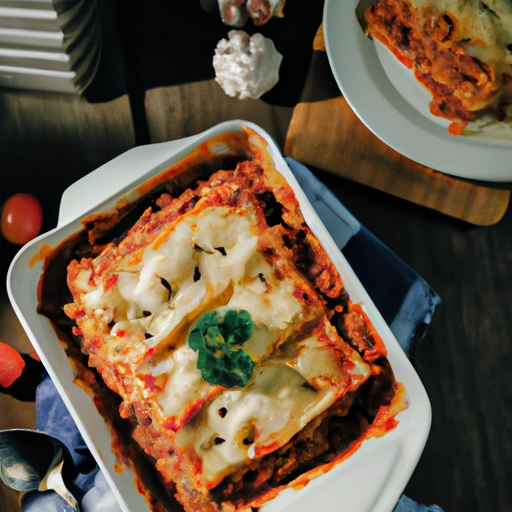Lasagna
Description

Lasagna, often referred to as 'lasagne' in many parts of Europe, is a type of wide, flat pasta that is typically used in layers to create the eponymous Italian dish. Each layer of lasagna noodle is alternated with sauces, cheese, meat, or vegetables. In the United States, the term 'lasagna' is commonly used to refer to the complete dish, while in Italy and other European countries, 'lasagna' refers specifically to the pasta itself.
Common uses
While lasagna is most commonly associated with the layered baked casserole, it also serves as a versatile ingredient in a variety of dishes. Its broad, flat surface makes it ideal for rolling and stuffing with a plethora of fillings, creating dishes like lasagna roll-ups.
Nutritional value
Calories
Plain lasagna noodles typically contain approximately 85 calories per ounce (28 grams), which is about 2 square sheets.
Protein
Lasagna noodles provide around 3 grams of protein per ounce, contributing to daily protein intake.
Fat
These pasta sheets contain negligible amounts of fat, with less than half a gram per ounce.
Carbohydrates
With about 17 grams of carbohydrates per ounce, lasagna is a significant source of carbs, providing energy to the body.
Vitamins
Lasagna noodles are not a significant source of vitamins, but when enriched, they can offer some B vitamins like folate.
Minerals
The pasta may contain small amounts of minerals such as iron and magnesium, especially when made from whole grains.
Health benefits
The carbohydrates in lasagna provide a quick source of energy, and when made with whole grains, it can be a good source of dietary fiber. The protein content, particularly when combined with cheese or meat, can help in muscle repair and growth. If prepared with vegetables, the dish can be enriched with various vitamins and minerals.
Potential risks
Consuming lasagna in large amounts can contribute to excessive calorie intake, which may lead to weight gain. For those with gluten intolerance or celiac disease, traditional lasagna noodles made from wheat can cause health issues. Moreover, high-sodium cheeses and sauces commonly used in lasagna recipes can increase the risk of hypertension if consumed frequently.
Common recipes
Lasagna is most famously used in the traditional baked lasagna al forno, layered with ragù (meat sauce), béchamel sauce, and Parmigiano-Reggiano cheese. It's also used in vegetarian versions that include a variety of vegetables.
Cooking methods
Lasagna sheets are usually boiled until al dente before being layered in the casserole. However, 'no-boil' lasagna sheets have become widely available, which absorb moisture from the sauce and cook during the baking process.
Pairing with other ingredients
Lasagna pairs beautifully with a side salad, garlic bread, or steamed vegetables. For wine pairings, a robust red wine like Chianti complements the rich flavors of meat-based lasagna, while a lighter Pinot Grigio pairs well with vegetable versions.
Summary
Lasagna is a beloved pasta variety known for its use in the classic Italian baked casserole. Composed of wide, flat noodles, it is enjoyed in diverse recipes worldwide. While nutritious in moderation, attention should be given to the accompanying ingredients to maintain a balanced diet.